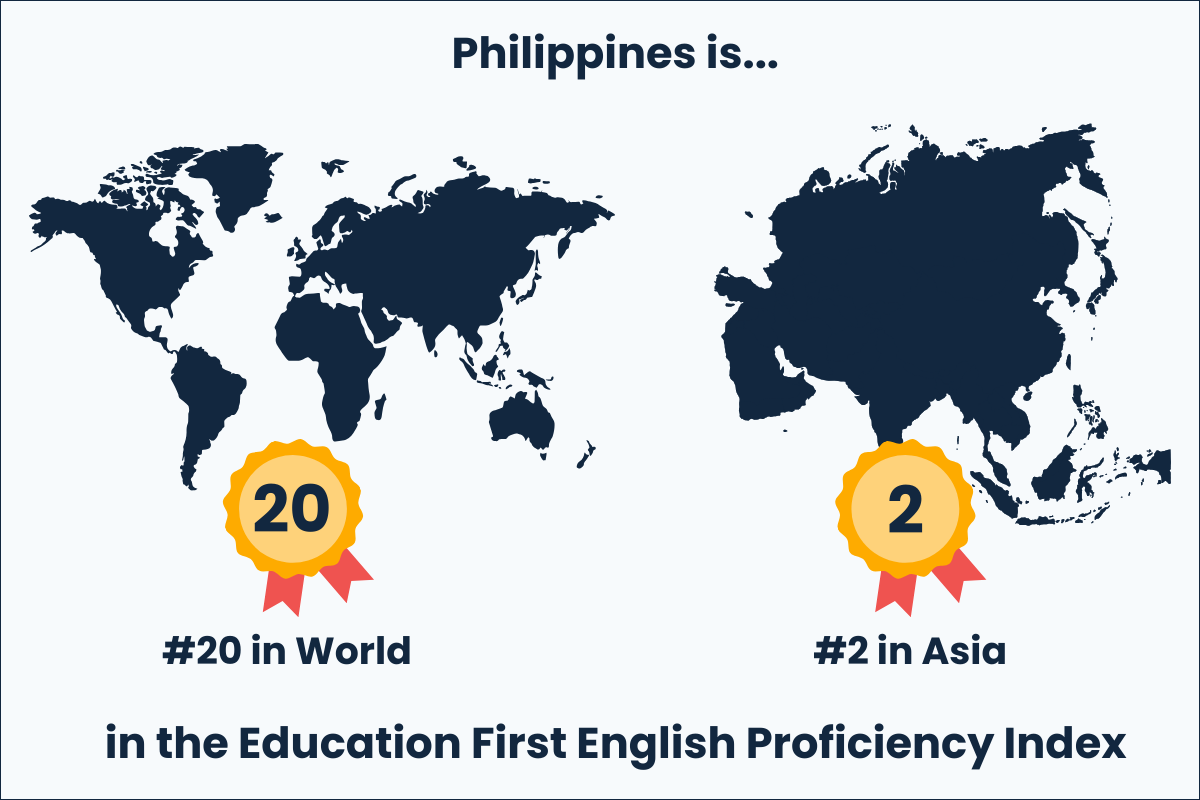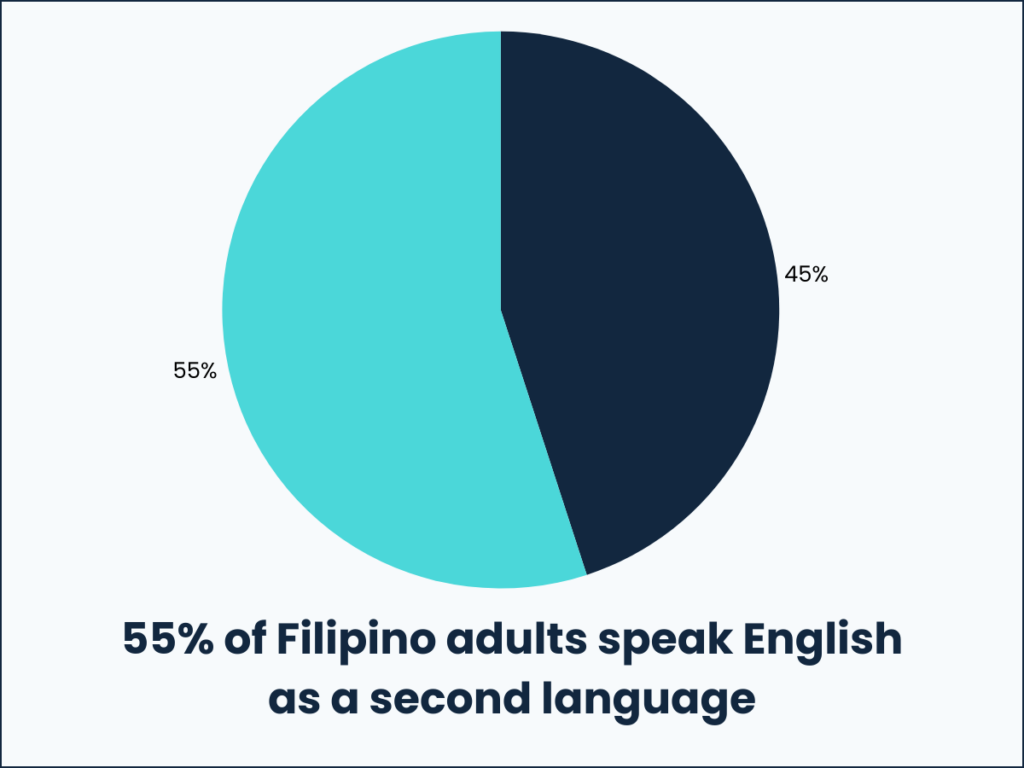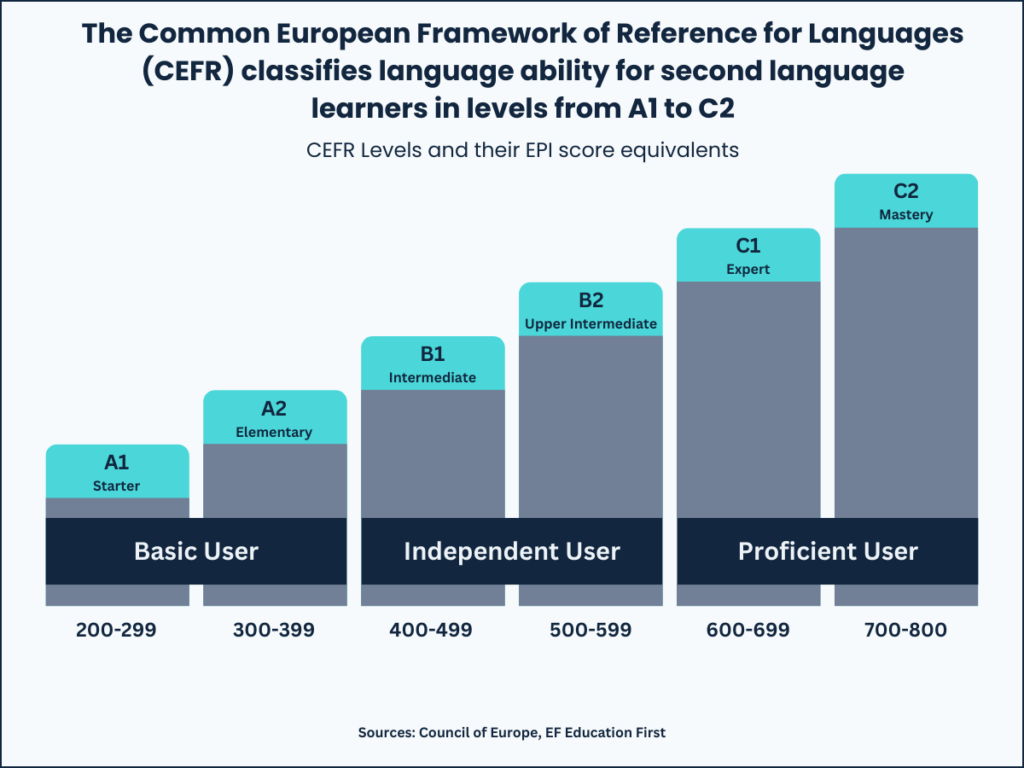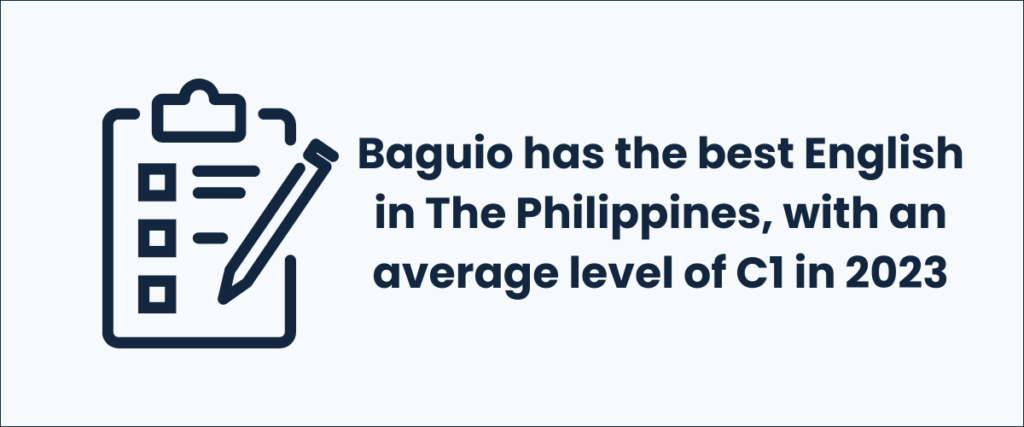How Many People in The Philippines Speak English?

The Philippines is unique from many points of view. It’s one of the largest and most culturally diverse countries in Southeast Asia, with well over 100 languages spoken throughout its territory. The Philippines is also one of the most English-friendly countries in the world.

English is a co-official language in The Philippines alongside Filipino, the national language. The vast majority of the population has some level of English knowledge. According to recent polls, roughly 55% of adult Filipinos speak English, though many more can write and understand the language well.
Not only that, but The Philippines consistently ranks among the top 3 most proficient countries in the region. In 2023, Filipinos were the second-best English speakers in Asia, and among the top 20 best English-speaking countries worldwide.
The widespread use of English and the high degree of proficiency among the population make The Philippines stand apart from many of its neighbors. The history and evolution of English in the country are also quite interesting. Keep reading to find out more about The Philippines’ unique language environment!
Number of English Speakers in The Philippines (General Stats)
Many Filipinos can speak Filipino and English, so a large share of the population is bilingual. The majority of people have a good grasp of English, though the figures vary depending on the language skill in question. Some people have a harder time speaking English even though they can understand the language, for example.
Let’s take a closer look at the numbers and facts:
- 55% of the adult population (39.4 million) speaks English, according to a 2023 poll conducted by the Social Weather Stations.
- As many as 80% of adults (57.4 million) can understand written and spoken English and 69% (49.5 million) can write English. According to the same poll, 47% of Filipinos (33.7 million) said they can think in English.
- The latest English Proficiency Index (EPI) ranks The Philippines #2 in Asia and #20 worldwide in terms of language skills.
- The Philippines had an EPI score of 578 points in 2023, ranking second place in Asia after Singapore (631 points).
- The Philippines’ EPI score is the equivalent of a CEFR level of B2 (upper intermediate). This means that English-speaking Filipinos can communicate with ease and efficiency.
- The Philippines outranked Malaysia (568 points) and Hong Kong (558), two Asian countries with considerable English-speaking populations.
- Some cities have very high English proficiency on average, especially Baguio, which ranked 1st in the country in 2023.
- Filipinos aged 26-40 have very high proficiency in English, equivalent to a C1 (advanced) level.
- Despite being the country’s official language, most Filipinos don’t learn English as a mother tongue. Only 0.04% of the population (45,560 people) in the country speak English as a first language. The vast majority of Filipinos learn English as a second or third language.
- Children in The Philippines start learning English in the first grade of elementary school (age 6 and up).
- English is on the rise. In 2023, 9% of Filipinos had full command of the English language, up from 5% in 2016. The share of those with good command of English also rose from 28% to 35% between 2016 and 2023.
Overall, English is widely spoken as a second language and a good proportion of the population can speak it fluently. The English language is especially common in formal settings like business, government, medicine, the legal system, and academia.
English also often features in elementary and high school education, being used as the primary medium of instruction for subjects like mathematics and science. Many people also speak English alongside Filipino Tagalog in casual settings. English is so common that many Filipinos nowadays speak “Taglish” (a combination of English and Tagalog) in their day-to-day life.
The widespread use of English in the country and the accessibility of excellent ELT education make The Philippines a top destination for foreign students from other countries in East and Southeast Asia, according to a 2015 article published by the British Council. Tens of thousands of international students come to The Philippines each year to study English, especially those from South Korea and Japan.
Sources: The Philippine News Agency, Education First 1 & 2, ResearchGate, Philippine Statistics Authority, Department of Education (GOVPH), ICEF Monitor
The History of English in The Philippines
Most nations in Southeast Asia have a history of Western colonial occupation. British, Portuguese, and Spanish influences are the most readily apparent in the region. The countries that used to be under British rule still use English as a co-official language today, and they rank among the top English-speaking countries in the world.
Such is the case for countries like Singapore and Malaysia, as well as Hong Kong, an administrative region of China. The Philippines is unique, though, because it’s the only country in the region to have adopted English from the U.S., rather than Britain.
After the 1898 Treaty of Paris, Spain ceded The Philippines to the United States. Following the end of the Philippine-American War in 1902, the new American administration introduced English as the primary language in the country. From that moment forward, English became the main language used in government, business, and the education system.
In less than four decades, a quarter of Filipinos had already adopted the English language, a rate of language assimilation never seen before. To put things into context, there were almost no English speakers in the country prior to the 20th century. By the time of the 1939 government census, 26.6% of the country’s population spoke English.
Even after The Philippines’ independence in 1946, the English language has maintained its official status in the country. The share of English speakers has only risen further through the following decades. Nowadays, English is commonplace in daily life. Most of The Philippine population has some level of English knowledge, with a majority of adults being able to speak the language fluently.
The English spoken in The Philippines is also unique. Compared to other top-ranking English-speaking countries in the Western world, The Philippines has adapted American English to its local environment, creating its own distinct variety of language known as “Philippine English.”
Unlike American English, Philippine English has slightly different intonation, use of vowels and certain consonant sounds, and unique vocabulary and grammar structures. The two varieties of English are very similar and mutually intelligible, apart from a few words of Tagalog and Spanish origin.
English also makes its way into Filipino (Tagalog) conversations, with many bilingual people speaking “Taglish,” a combination of English and Tagalog. Taglish often uses English words as neologisms or as synonyms in place of words that are too long or difficult to pronounce in Tagalog.
Sources: The Oxford English Dictionary, ResearchGate, Wikipedia
English Speakers in The Philippines by Region
The vast majority of Filipinos can understand written and spoken English. All regions likely have a decent number of English speakers. However, by total numbers, the highly developed regions are likely to have the most fluent speakers. Those include:
- Metropolitan Manila (also known as the National Capital Region)
- Davao Region
- Central Visayas (especially the Cebu province)
Certain demographic groups like business workers, university students, doctors, and state workers, in particular, are more likely to use English in their daily lives. Unsurprisingly, the most affluent regions, known for their industries, international businesses, large universities, and large state facilities, will attract the largest English-speaking demographic.
These regions are also among the top five in the country in terms of English proficiency. According to 2023 EPI data, the Davao region has very high proficiency on average, the equivalent of a C1 level according to the CEFR.

The regions with the best English skills in 2023 were:
- Cordillera Administrative Region
- Davao
- Eastern Visayas
- National Capital Region (Metro Manila)
- Central Visayas
However, most other regions in the Philippines have similar proficiency levels. Here’s how the rest of the country compares:
| Region | Proficiency Score | Proficiency Level | CEFR Level |
| Cordillera Administrative Region | 616 | Very high | C1 |
| Davao | 606 | Very high | C1 |
| Eastern Visayas | 596 | High | B2 |
| National Capital Region (Metro Manila) | 593 | High | B2 |
| Central Visayas | 589 | High | B2 |
| Mimaropa | 589 | High | B2 |
| Cagayan Valley | 587 | High | B2 |
| Bicol | 585 | High | B2 |
| Caraga | 579 | High | B2 |
| Zamboanga Peninsula | 576 | High | B2 |
| Calabarzon | 574 | High | B2 |
| Central Luzon | 568 | High | B2 |
| Autonomous Region in Muslim Mindanao | 568 | High | B2 |
| Soccsksargen | 560 | High | B2 |
| Western Visayas | 536 | Moderate | B2 |
| Ilocos | 529 | Moderate | B2 |
| Northern Mindanao | 514 | Moderate | B2 |
There was a 102-point difference between the top and bottom-ranked regions. However, no part of The Philippines had a proficiency lower than B2 (upper intermediate). People with this level know English well enough to understand complex ideas and communicate effortlessly even with native speakers.
Of course, these are just averages. The English Proficiency Index almost invariably includes test takers aged 18-60 years old, and the median age is 26 years old. The EPI ranking includes all regions with at least 400 test takers, so there can be a lot of variety between sample populations among different regions.
Sources: Statista, Education First 1 & 2, British Council
English Speakers in The Philippines by City

English is prevalent in large, highly urbanized cities, where Filipinos of all ages and proficiency levels likely encounter the language daily. Some of the cities with the most English speakers include:
- Manila
- Quezon City
- Cebu
- Baguio
- Taguig
These cities are also some of the most visited locations in the country by Filipinos and foreigners alike. Multiple factors make these urban centers highly attractive for the English-speaking workforce and inbound visitors:
- Manila is the capital city of the country and the second-largest city nationwide. There are an estimated 60,000 establishments locally, making the city a hub for various industries including banking and finance, retail, commerce, tourism, real estate, media and publishing, art and fashion, and more.
Besides its high economic competitiveness, Manila has also been an epicenter of education and culture in the country. The city houses some of the most important universities in the country, including The University of Santo Tomas, The University of the Philippines Manila, and De La Salle University.
- Quezon is the largest city in The Philippines and one of the most modern urban centers in the country. Like Manila, Quezon is a flourishing business hub in the country, attracting numerous foreign investors and foreign companies. Quezon has consistently been the #1 most competitive city nationwide from 2015 to 2019.
Quezon is currently the second richest city in The Philippines, as well as the entertainment and ICT capital of the country. Besides technology and entertainment, the city is also a powerhouse in terms of commerce, finance, tourism, healthcare, retailing, legal services, and advertising.
- Cebu is among the richest cities in the country, being ranked 4th place nationwide by GDP per capita. Currently, Cebu has one of the largest tourism industries in the country, attracting millions of visitors every year.
As one of the oldest cities in The Philippines, Cebu provides major cultural attractions including ancient and colonial architecture, temples, museums, and yearly festivals like Sinulog and Halad Inasal. Last but not least, Cebu is one of the top destinations for business process outsourcing, especially in the IT sector.
- Baguio is also known as “The Summer Capital” of The Philippines. The city was once the designated hill station of the United States. Nowadays, Baguio is known for its refreshing highland climate, modern American-style architecture, and large retail sector.
Being one of the top tourist destinations in Asia, Baguio has an expansive tourism industry with numerous restaurants, shopping centers, cultural events, and over 80 places of accommodation. The city is also a top destination for the English-speaking workforce in the country; international ESL schools and business process outsourcing are major contributors to the local economy.
- Taguig is well known for its vibrant contemporary culture. The city is home to the renowned Mind Museum, a highly modern world-class institution dedicated to promoting science, technology, and innovation. Taguig’s “Bonifacio Global City” district is another major local attraction, known for its numerous art installations and other cultural events.
English is the most common language used on the cultural scene, which makes the local attraction easily accessible to visitors from all over the world. Last but not least, Taguig is home to multiple reputable international schools, including the British School Manila and International School Manila.
In terms of English proficiency, Baguio had the best English speakers in 2023. Here are the top 5 cities with the best proficiency scores:
- Baguio
- Dumaguete
- Davao City
- Dasmarinas
- San Jose del Monte
Cebu and Manila also had high scores, although they didn’t make it into the top 5. Unfortunately, Quezon and Taguig weren’t included among the 19 cities reviewed in 2023. Here’s how the rest of the cities stack up:
| City | Proficiency Score | Proficiency Level | CEFR Level |
| Baguio | 618 | Very High | C1 |
| Dumaguete | 617 | Very High | C1 |
| Davao City | 609 | Very High | C1 |
| Dasmarinas | 606 | Very High | C1 |
| San Jose del Monte | 606 | Very High | C1 |
| Bacolod | 605 | Very High | C1 |
| Antipolo | 599 | High | B2 |
| Angeles | 599 | High | B2 |
| Manila | 587 | High | B2 |
| General Santos | 584 | High | B2 |
| Bulakan | 583 | High | B2 |
| Cebu City | 576 | High | B2 |
| Batangas | 575 | High | B2 |
| Iligan City | 545 | Moderate | B2 |
| Tarlac City | 535 | Moderate | B2 |
| Cagayan de Oro | 503 | Moderate | B2 |
| Dagupan | 503 | Moderate | B2 |
| Iloilo | 502 | Moderate | B2 |
| Calamba | 484 | Low | B1 |
Most of the Philippine cities included in the 2023 statistics had upper intermediate or advanced English skills on average. This trend reflects the widespread acquisition and use of English throughout the country. Calamba is the only city to have a low proficiency level and a score below 500 points.
Sources: PhilAtlas, Wikipedia 1, 2, 3, 4, 5, & 6, Education First 1 & 2
English Speakers in The Philippines by Demographic Group

Due to the colonization by the U.S., English has been the main language used in Philippine schools, academia, politics, business, and science for over 100 years. Even after The Philippines gained its independence, English remained one of the country’s official languages.
Nowadays, most of the population has at least some level of English knowledge thanks to the frequent exposure to the language, especially in school. The vast majority of Filipino adults can understand written and spoken English. However, only roughly 1 in 2 Filipinos can actively speak the language.
English skills can vary considerably between different demographics, especially among different age groups and socioeconomic backgrounds. Here’s a more in-depth breakdown:
- Young adults are the most likely to speak English. The number of Filipinos who can speak English has risen over the past two decades, from 32% in 2006, to 46% in 2008, and to 55% in 2023. College graduates contributed the most to the increase in speakers.
- Both men and women had high English proficiency scores in 2023, with a difference of only 3 points on average.
- Adults aged 26-40 had the highest English proficiency of all age groups in 2023, reaching a score equivalent to a C1 level.
- Proficiency has been steadily increasing in adults aged 21-41+. At the same time, the 18-20 age group has been slowly declining since 2019. In 2023, those under 20 were the only age group with a proficiency score under 550 points.
- Older adults might be less likely to speak English. In 2019, Filipino adults aged 50-64 had lower rates of functional literacy, compared to other age groups.
- On the other hand, some of the older adults who do speak English might have higher proficiency on average. The elderly population today is the last generation to have attended school during American rule (which lasted until 1946).
During this period, English was heavily emphasized, and children aged 6 and older had access to classes taught mainly by native speakers. Extended English education programs were also available for adults, though access depended upon location and one’s financial means.
- Even today, socio-economic status plays a big role when learning English. A comparison of English scores among students of different backgrounds found that learners with a lower socio-economic level consistently scored lower than their peers.
- English is crucial in the job market, especially in international companies and administrative state jobs. High-earning Filipinos working white-collar jobs are more likely to speak fluent English.
Overall, the people most likely to speak fluent English are young college graduates and high-earning adults between the ages of 26-40. Those of a higher socio-economic status have higher proficiency on average. These statistics also support the higher proficiency scores registered in The Philippines’ large cities and affluent regions.
Sources: ABS-CBN, The Philippine News Agency, Education First, Philippine Statistics Authority, ResearchGate, UP Department of Linguistics
Conclusion
The Philippines stands out as one of the most English-friendly countries in Asia. English is a co-official language in the country, and the vast majority of the population has some degree of English knowledge. Roughly 1 in 2 Filipino adults can speak the language, though many more can understand written and spoken English.
Given the widespread use of English in schools, government, and media, it’s no surprise that The Philippines is among the best English-speaking countries in the world. As of 2023, The Philippines is 2nd in Asia, and 20th worldwide in terms of English proficiency.
FAQs
Are Filipino and Tagalog the same language?
The words “Filipino” and “Tagalog” are often used interchangeably, though they mean slightly different things. “Tagalog” is one of the many Filipino languages, most of which are part of the Austronesian language family. Tagalog is also the most widely spoken language in The Philippines. As any other language, Tagalog also has multiple regional dialects.
“Filipino” is the standardized form of Tagalog based on the Manila dialect. It’s also one of the official languages of The Philippines. Filipino is regulated by The Commission on the Filipino Language and it’s the main local language taught in schools. Filipino arose out of a need for a unifying national language for the Filipino people.
How many languages are spoken in The Philippines?
The Philippines is a linguistically diverse country with over 180 languages spoken throughout the archipelago. Most of these are indigenous languages of Malayo-Polynesian origin. Some Filipinos also speak Spanish, Spanish-based Creoles, and various foreign languages.
Tagalog, Illocano, Ilonggo, and the Cebuano language are the most widely spoken native languages that originated locally. English, Spanish, Japanese, Malay, and Hokkien were introduced into the country, and are still major immigrant languages. Of those, the Spanish language, and later English, were the most influential. They had a wide-reaching impact on Tagalog and other local languages.
What is the dominant language used in The Philippines?
There are two official languages in The Philippines, English and Filipino, the standardized version of Tagalog. Of those, Filipino is the most common of all Philippine languages. Filipino is primarily spoken in daily life, especially outside of formal settings.
While English is a co-official language, Filipino is the only national language of the country, as codified in the 1987 constitution. Roughly 90 percent of the population speaks Filipino, and almost 40% of the country speaks other Tagalog varieties as a native language.